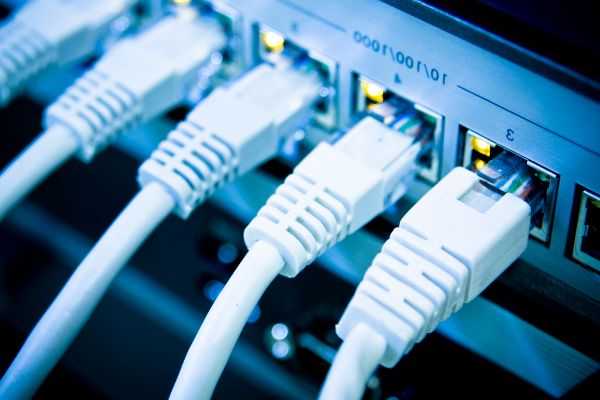Disclaimer: This post may contain affiliate links, meaning we get a small commission if you make a purchase through our links, at no cost to you. For more information, please visit our Disclaimer Page.
Connectivity is one of the most important aspects of modern computing. Primarily, it is the way that your computer will communicate with servers across the world in order to access the internet and bring you new information. However, there are other kinds of connectivity that fall under a broad umbrella. It is also what you would use to connect several computers across the same local network.
Furthermore, it could be the means by which you might allow peripheral devices like printers or scanners to talk to each other and various computers. An ethernet switch is one of the ways you can gain this kind of connection. This switch has a connection to your modem or router to help you access the internet, too. Your own router has an ethernet switch with a few ports.
Because it is such a major function of the router and its network, some users wonder if the ethernet switch on their devices can have some kind of impact on network latency. We will talk a bit about what latency is, and we will dive into whether the switch can have any effect on it.
Additionally, we will discover some of the most common culprits of high latency figures in a network, how switches in the network might improve latency numbers, and talk about potential speed differences between common network switches and routers.
Table of Contents
What Is Network Latency?
Network latency is a delay in communication between lines. In the tech world, people will often refer to latency as lag. If you are familiar with various online forums about computers and the internet, you may see that one of the primary goals of many computer users is to reduce lag as much as possible.
Making network latency as low as it can be means that communication between two points goes faster, but it also means that any applications you might use online should be smoother, more responsive, and easier to operate.
When you are online, your device is sending and receiving packets of data. If you think of those packets as physical objects, latency is the time it takes for your machine to get a response to a data packet that it sent out earlier. Your computers and other devices send out queries based on what you want to do with online applications, and they need to wait for responses before they can perform some of their actions.
If network latency is high, the response time is going to be much longer. In turn, all of this can cause the programs you are using to seem slow or glitchy, even though the real culprit is probably the network.
It may be easier to illustrate this example using online gaming. A fast, stable internet connection is one of the foundations of good online gaming. Your computer connects to the game developer’s servers, and those servers send you and your characters into the virtual sandbox the company creates for its players.
Thousands of other players may do this at the same time, and you may play with dozens of gamers who also log into the same regional server that you do, too. In most cases, this process is automatic, and the game will ask you to select the server that is the closest one to your physical location.
If there is a lot of latency on your network, the actions or movements of both your character and those in the game world will seem very stiff. In most cases, you’ll input an action, and your character may take several seconds to complete it.
You may not even see the animation frames in action. Players on the other end may also have problems viewing your character and their actions.
All of this would be the result of high latency, or a network that tends to lag quite a lot.
What Causes High Latency? 4 Things
Before we get into what might cause high latency, we need to define ping. Ping is another term that you might hear a lot about when you are looking into the topic of latency. These things have a close relationship with each other, but they are not the same.
Ping is the amount of time it takes for one computer to send a signal to another device. Alternatively, latency is a measurement of how long it takes for the original device to get a signal in return. You can think of it as a one-way trip compared to a full one.
Here are some of the common things that can cause high latency:
1. Although you may not be able to do much about it, your internet service provider could be the source of your latency issues. Depending on the region where you are, you may only have access to one local provider of internet connections.
They may not be on the best network, or they may not have high speeds available for their customers. In these cases, you could experience high latency when using resource-intensive applications that require a good, fast connection in order to work smoothly.
2. Even if you have a good ISP, you may have chosen a relatively slow capped internet speed for your package. If so, it could cause latency that is too high for much of what you’d like to do. You can try upgrading to the next speed tier to see if this helps to solve the issue.
3. Bandwidth issues could plague your connection and cause high latency, and this is true even if you have a good package. Most ISPs don’t publish latency numbers consistently, but having multiple connections in the same household or area will use up more of the bandwidth at your disposal.
This will cause high latency when you do things like stream or play games.
4. A good firewall will check the data packets you send and receive. Since it takes time to do so, your firewall’s settings may make your latency higher than it needs to be.
Do Ethernet Switches Affect Latency?
Ethernet switches can impact latency measures, but there are several factors involved in this. Which is to say, it might be hard to measure how much a switch creates any latency, and much of this will depend on different things.
Here are just a few of the common elements of an ethernet switch that may add to or reduce lag:
1. Different ethernet links can use various speeds to send data through the network connection. Many ethernet switches will operate in hundreds of megabytes or gigabytes. The higher the rating of the switch, the faster information can travel through it.
However, even in the cases of switches on the lower end of the speed spectrum, data should still pass through in a matter of nanoseconds.
2. The forwarding mode of the switch can also reduce this lag time. If the architecture of the ethernet switch is able to use something like cut-through mode, then some data packets can start going through the network even as the hardware is still reading the data.
This can reduce the time it takes for network communications.
3. Various switches might have different numbers of stages that data goes through. On balance, a switch with fewer stages can decrease the latency of the network. This is because the data needs to pass through fewer checkpoints on its way there and back.
In general, smaller switches have fewer stages, but you might find some smaller form factors that have many stages, too. These stages would account for things like buffers or additional features.
In short, many newer switches can measure their data latency number in nanoseconds. Older switches that run on unsophisticated hardware may measure this lag in microseconds instead.
Can a Network Switch Improve Internet Speed?
A network switch may improve your internet speed, but it depends on what you have available already. It may be easier to illustrate this by explaining how a network switch might cause latency.
If you have an internet speed package that offers you a 1Gbps connection, but you have a switch that only allows for 100Mbps, the switch may slow down the connection somewhat.
However, most switches can handle internet speeds that can go far beyond the speeds that many people are able to purchase from their ISPs. If you have an old switch, bad cabling, or speeds that do go faster than your current switch, an upgrade to a different model may improve your speeds.
Is a Network Switch Faster Than a Router?
The precise answer to this question can depend on the models and settings for both the switch and the router. However, if we are dealing with two pieces of tech that we see as equal, the switch is probably the faster of the two.
Mostly, this has to do with how the devices function. A switch will transmit data between two devices on the same network, and it can only see devices that plug into it.
Conversely, a router sends data between different networks. Because it is working with different networks, the router might be a little slower than the switch. However, it isn’t very fair to compare and contrast the two devices. Although they are similar, they perform different jobs.
Conclusion
A common ethernet switch will help you connect various wired devices across one local area network. While there is a chance for you to see some latency on a switch that is old or using improper configurations, most of these devices should relieve some of the strain on individual devices that you might use.
They may also improve network speeds and bandwidth, but you might need to upgrade and configure yours properly first. Although a switch like this is similar to a router, they are two interconnected pieces that serve separate functions.


